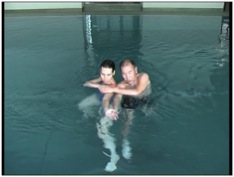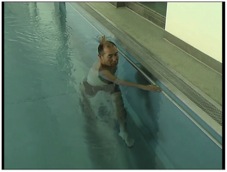Ai Chi was developed in 1993 by Jun Konno, owner of the Aquadynamics Institute in Yokohama. He created Ai Chi as a preparation for Watsu, which is based on stretching meridians and creating balance between yin and yang, according to the philosophy of Masunaga.1 At this time, Ai Chi consists of 19 movements or kata’s.
Ai Chi can be characterized as a series of continuous slow and broad movements, accomplished without force. It consists of movement patterns of the arms, arms and trunk, and arms, legs and trunk, with gradual narrowing of the basis of support combined with deep breathing. Movements are supposed to take place at breath rate, about 14 to 16 times per minute.
Ai Chi has elements of both Qi Gong (a more static and symmetrical posture during the initial 6 arm movements) and Tai Chi Chuan (more focused on continuously changing the centre of gravity within the basis of support in the latter part). The classical purpose within Eastern theory is to balance energy by stretch of certain meridians.
Meridians that are stretched are the meridians of:
- The lung (underneath the clavicula), by retracting the scapula
- The small intestines (underneath the scapula), by protracting the scapula
- The urine bladder (accross the sacrum), by rounding the back and “opening” the SI joint
- The kidney (across the stomach), by extending the thoracal-lumbar spine and “opening” the stomach area
- The gallbladder (at the lateral waist), by rotation in between pelvis and thorax
Three other meridians are addressed: the long intestines, the pericardium and the triple warmer. These all end at fingertips and cannot be stretched. Through supinating the forearms and hands at every inhalation and pronating at every exhalation, yin and yang can be balanced as well.
There are three key elements that are essential in learning and practicing Ai Chi.2,3
- Listening inward to feeling. Listening inward to feeling is directing attention to ones internal environment. This is the preparation for the next key element.
- Breath Modulation. As we listen inward to feeling one becomes aware of breathing. At this stage it is very important to focus attention on your abdomen and fully relax any tension there. With inhalation and exhalation, the body and mind naturally begin to relax and one can feel the changes in buoyancy that occur as the lungs fill and empty.
- Relax. Relaxation is a natural process of letting go of excess tension in body and mind. As relaxation proceeds even deeper, breathing becomes more rhythmic and smooth. This begins to release tension in the muscles and joints which increases internal energy (Chi) flow.
These three key elements are components of a progression. One flows into the other as the components mix to become a foundation by which all other practice takes form.
This chapter however will not focus on the Eastern philosophy underlying Ai Chi. In western terms, Ai Chi could be described as an active relaxation technique in which postural control and breathing are important.
Clients stand in shoulder deep water, preferably in the Tai Chi positions with knees slightly flexed. The water (and air) temperature should be thermo-neutral in order to support active relaxation. Clients that are apprehensive can perform an adapted Ai Chi while holding a bar. This is called Wall Ai Chi (figure 1). After Ai Chi, which is done individually, Ai Chi Ne (figure 2) can be included as an activity in pairs in order to finally go into Watsu.
Ai Chi has also been adapted for clients who are unable to stand and thus are allowed to sit on a stool in shallow water. This may be useful for patients with paralysis in one or both legs or even low back pain patients and may be integrated with other techniques.

Ai Chi Ne

Wall Ai Chi
Clinical Ai Chi
The term Clinical Ai Chi is used in order to distinguish it from regular Ai Chi as applied in wellness. Clinical Ai Chi may be used for specific therapeutic applications, which should be based on a certain evidence level. The use of the term Clinical Ai Chi has been granted by Jun Konno to the Association International Aquatic Therapy Faculty (IATF) in Switzerland.


